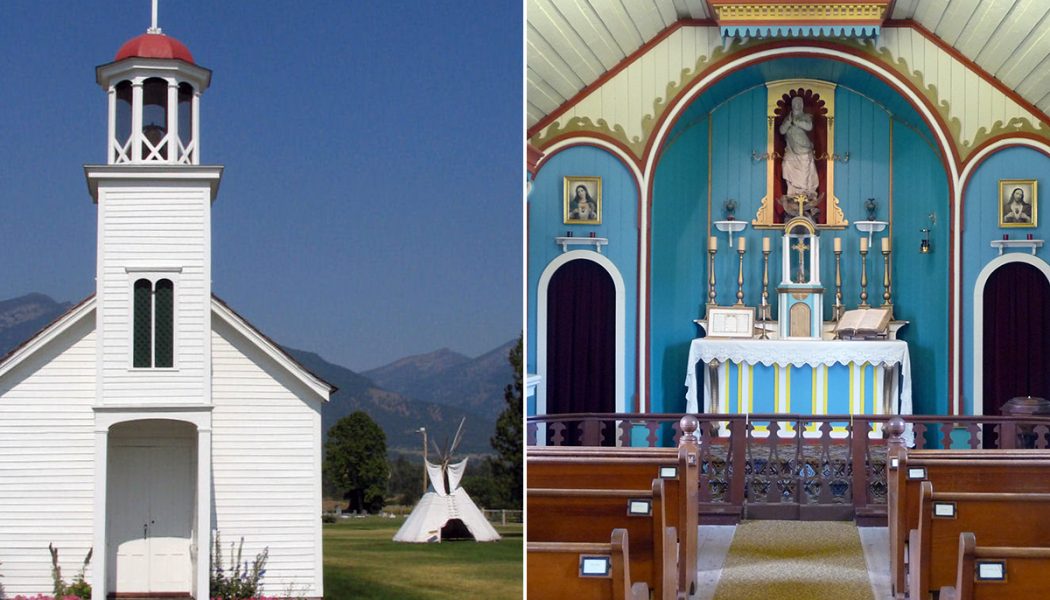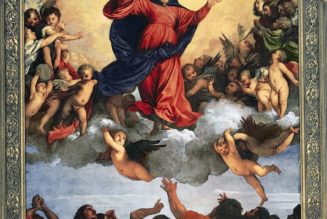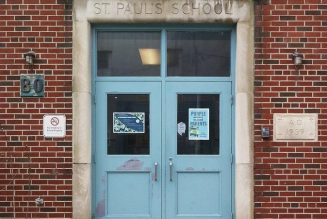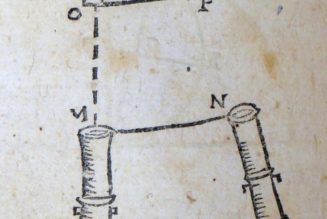It was Christmas Eve, 1841, in Montana’s Bitterroot Valley. Montana was still decades from statehood. The Salish Indians in that locality had welcomed missionaries only in September.
Father Pierre-Jean De Smet, the well-known Jesuit missionary, had arrived with two fellow priests to found a mission among the Salish, also then called the Flatheads, who were eager to learn the Catholic faith and be baptized. They had heard of the “Black Robes” from some Iroquois adopted into their tribe and sent members to St. Louis to request Black Robes to teach them.
On that Christmas Eve, in the little village named St. Mary’s by the missionaries, one 11-year-old Indian boy wanted to be baptized, too, but could not — try as he might, he could not learn the prayers or catechism.
One of the priests with Father De Smet, Father Nicolas Point, would write that this boy called Little Paul had “barely passed beyond the age of early childhood” and had such poor memory that “in spite of all his efforts, he had been unable to learn what was rigorously required for the reception of the sacrament.”
That Christmas Eve, wanting yet again to try to learn his prayers so he could be baptized, Little Paul went to the hut of his friend Jean. Instead, he found someone else.
Waiting to greet him there was the Blessed Virgin Mary.
What happened next was detailed by Father De Smet. In one place he recorded what Little Paul told him. He wrote, “Upon entering Jean’s hut, whither I had gone to learn my prayers, which I did not know, I saw someone who was very beautiful — her feet did not touch the earth, her garments were as white as snow; she had a star over her head, and a serpent under her feet; and near the serpent was a fruit which I did not recognize. I could see her heart, from which rays of light burst forth and shone upon me. When I first beheld all this I was frightened, but afterwards my fear left me; my heart was warmed, my mind clear, and I do not know how it happened, but all at once I knew my prayers.”
It was a miracle of infused knowledge.
“The eve of this solemnity was rendered remarkable by an extraordinary event.” Father De Smet would later retell in more detail the story in his Origin, Progress, and Prospects of the Catholic Mission to the Rocky Mountains, which is worth repeating. The boy “who had for several months attended catechism, finding himself incapable of learning the prayers, gave up in despair. and discontinued his attendance. On the Eve of Christmas, his mother said to him — ‘Paul, the Great Spirit will be angry with you, and will never admit you into heaven if you do not learn your prayers.’
“‘Mother,’ answered the boy. ‘the Great Spirit will take pity on me — I tried to learn my prayers, and I have been unable to do it. However, I will go again and try.’ He then directed his steps towards lodge of one of the catechists. On opening the door, he saw a person standing about two feet from the ground, in the midst of bright rays of light, dressed all white: under the person’s feet was a sphere, a half moon, and a serpent, with a strange fruit in its mouth. Above the person’s head was a bright star — the heart was visible, and rays of light proceeded from it. At first he was afraid. and was upon the point of running away. But on taking a second glance at the person, he perceived a smile on (the) countenance, which filled him with confidence. He kneeled and begged of the person to teach him his prayers. Suddenly he felt his mind clear and his heart warm — such are the child’s own expressions — and he recited the whole of the prayers without difficulty.”
“He returned immediately, and told his mother he knew his prayers. She would not believe it. He recited them in her presence and knew them so accurately that he corrected his sister, who mistook two or three words. He then related the story.”
DeSmet and the priests with him questioned him. “I showed an image of an apparition of the B.V. (Blessed Virgin) to Paul,” Father De Smet continued. “He recognized her immediately, with this difference, that he saw her only with one star, with her hands joined before her breast, and with her heart visible. The circumstance of the single star coincided singularly with the festival of Christmas.” One of the brothers there with the priests later would say the picture was of the Immaculate Conception.
The priests totally believed him. “The candor, the simplicity, the piety of the child — the perfect consistency of his answers to all the questions put to him, and above all, the fact that he had hitherto been unable to learn his prayers, and that on a sudden he was formed to know them perfectly plainly show that our Blessed Lady had really favored this poor child in this extraordinary manner.”
Immediately, the story of what happened got around. Because of the boy’s known piety and sincerity, no one doubted the truth of what he said. And there was the proof that all of a sudden, he knew everything he needed to learn and was unable to for many weeks.
Nothing could stop him now from being baptized. That Christmas day, among the 150 Father De Smet himself baptized was Little Paul.
In the book St. Mary’s in the Rocky Mountains, Lucylle Evans noted that Father De Smet also explained that Little Paul also told how the same person appeared to him while he was sleeping “and once she told him that she was pleased that the first village of the Flatheads should be called ‘St. Mary.’ … Several persons interrogated the boy on the subject and found him unvarying in his answers. By his conduct he was the angel of his tribe.”
Precedent of the Miracle of Infused Knowledge
To switch gears for a moment, another miraculous infusion of knowledge happened less than a year later, thousands of miles away in Rome, when a rabid atheist and Jew who attacked the Catholic faith entered the Church of Sant’Andrea delle Fratte. A friend had challenged him to wear a Miraculous Medal, which he did. There, the Blessed Mother appeared to Alfred Ratisbonne and he was miraculously converted.
Ratisbonne would write:
“I had only been in the church a short while when, all of a sudden, I felt totally uneasy for no apparent reason. I raised my eyes and saw that the whole building had disappeared. Only one side chapel had, so to say, gathered all the light. In the midst of this splendor, the Virgin Mary appeared standing on the altar. She was grandiose, brilliant, full of majesty and sweetness, just as she is in the Miraculous Medal. An irresistible force attracted me to her. The Virgin made a gesture with her hand indicating I was to kneel and as if saying ‘very good!’ Although she did not say anything, I understood everything.”
Intuitively, he was given knowledge of the Catholic faith and belief in it. He again wrote, “I cannot tell how I knew it, any more than I can account for the truths of which I had suddenly gained both the knowledge and the belief. All I can say is, that the moment when the Blessed Virgin made a sign with her hand, the veil fell from my eyes…” Naturally, he converted. Pope Gregory XVI wanted to meet him and have the Vatican investigate. The Holy See called it a miracle. Ratisbonne would eventually follow his brother into the Catholic priesthood.
Montana’s Miracle
St. Mary’s Mission is in today’s town of Stevensville, which is 144 highway miles from the state’s capital of Helena. St. Mary Peak, tallest mountain to the west, rises over 6,000 feet above the plain and, naturally, was named by Father De Smet who also named the mountain to the north of it St. Joseph Peak.
Our Lady was immediately honored when they entered the Bitterroot Valley, and St. Mary’s Mission Parish became the first church of the North West Territories.
Devotion to Our Lady grew ever stronger after her apparition.
The Jesuit brother with the priests wrote how he “made a chapel [it was a shrine] and a pedestal for a statue carved by Father Point and every night after prayers we went there to say 3 Hail Marys.”
Shortly after Little Paul had seen our Blessed Mother, the Salish had regular processions rising from the event. From the chapel entrance to the place where our Blessed Mother appeared to Little Paul, they decorated the green path with garlands leading to the pedestal on which the statue of Our Lady was placed. They processed from the chapel, led by a banner of the Sacred Heart, singers strewing flowers, followed by two priests then the two chiefs and the people enthusiastically thanking and praising the Blessed Mother.
In August 1842, Father De Smet put in writing how they had first observed the month of Mary, explaining that “the exercises were attended with as much piety and edification as in the most devout parishes in Europe. At the end of the month a small wooden statue of the Blessed Mother, made by one of the missionaries, was borne in triumph to the very place where our Blessed Mother deigned to honor us with the aforementioned apparition. Since that day a sort of pilgrimage has been established there, under the name of ‘Our Lady of Prayer.’ None pass the pious monument without stopping to pray on their knees. The more devout come regularly twice a day to speak to their Mother and her divine Son, and the children add to their prayers the beautiful flowers they can cull in the prairies.”
The apparition also led shortly after to the conversion of large numbers of the Nez Perce tribe. When the Salish told them of the apparition, “they sent for the boy, questioned him and cross-questioned him, till at length fully convinced of the reality of the vision, they said, ‘That prayer must be true, since the Great Spirit has sent the Mother of his Son to teach it to the Flatheads,’” recounted Father De Smet. Within two months all the Nez Perce were baptized.
Our Lady’s Other Montana Apparition
When the missionaries arrived in 1841 and chose the location, they began the mission the first Sunday of October on which the Church at that time celebrated the feast of Our Lady of the Rosary. They planted a cross on the spot “they had chosen for their first residence,” wrote Evans. “All of the Flatheads, from the great chief to the smallest child, piously pressed their lips to the wood which was the instrument of the world’s salvation, and on their knees took the solemn promise of dying a thousand times rather than abandon prayer (religion).”
So “many favors had been granted the missionaries through the intercession of the Mother of God that they unanimously proclaimed Mary the protectoress of the mission and gave her name to their new residence.”
Later, on Aug. 15, 1842, Father De Smet wrote that “on the day we took possession of the Blessed Mary’s new demesne, we set up a large cross in the middle of the camp, a circumstance rendered more striking from having, as they assured me, been predicted by the young girl called Mary, of whom I spoke to you before.”
Writing about the event more than once, he said that once they chose a site for the church, all the Salish worked together to construct in a few weeks the log which was remarkably able to hold 900 people.
“The church had been completed for several days, when one of them suddenly exclaimed: ‘Why this is the very spot on which little Mary said the church would be built!’ The circumstance was this — During my absence, one of the hunting bands had encamped in this valley, and a little girl of 12 or 14 years of age had here fallen sick and died. But previous to her death, she had earnestly asked for baptism — I instructed two or three Indians how to administer baptism, in case of emergency.” An Iroquois named Pierre who had been adopted into the tribe baptize her.
“Overjoyed at having received the sacrament of regeneration,” Father De Smet went on, “the poor child thanked God with all her heart, and invited the others to join with her — they did so — suddenly she cried out: ‘O! there is no happiness in this world — happiness is only to be found in heaven. I see the heavens opened, and the Mother of Jesus inviting me to go up to heaven.’ Then turning to the astonished Indians, she added, ‘Listen to the black-gowns when they come — they have the true prayer — do all they tell you — they will come — and on this very spot where I die, they will build the house of prayer.’ After these words she expired.”
Apparition Lived On
Although Little Paul died two years after his baptism, the apparition lived on in the devotions and memory with a constant reminder — a large painting done by Father Anthony Ravalli, a Jesuit who joined the mission of St. Mary’s in 1845.
Father Ravalli’s painting of the Blessed Mother’s apparition to Little Paul, now at another Jesuit mission in Montana, was replaced a little later by an exquisitely beautiful copy of it that is now in the Saint Mary Mission Chapel. The 6-foot-3-inch by 4-foot-10-inch painting, believed to be by Jesuit Brother Joseph Carignano, who did many murals at the turn of the 20th century, shows Our Lady surrounded by an arch of 12 stars and six cherub faces, angelic faces. She appears in the teepee as Little Paul kneels looking at her, his hands folded in prayer. Another child lies sleeping in the teepee to depict Little Paul when Our Lady also appeared to him in his dreams.
Visitors today behold this painting and learn of the apparitions when visiting historic St. Mary’s Mission’s fourth chapel dating to 1866 then doubled in size in 1879.
This year marks the 180th anniversary celebration of the founding of the town whose name was eventually changed to Stevensville, but still “St. Mary’s Mission stands in the shadow of St. Mary’s Mountain,” says Coleen Meyer, director of Historic St. Mary’s, noting the town’s slogan is “Montana’s First Best Place.”
Why wouldn’t it be, since the Blessed Virgin Mary appeared there to Salish children?


Join Our Telegram Group : Salvation & Prosperity








